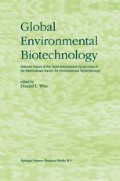Abstract
Polycyclic aromatic hydrocarbons (PAHs) are a major source of environmental contamination. The origin of PAH contaminated soil includes abandoned manufactured gas sites, leaking underground storage tanks, wood treatment sites and current industrial processes [1–4]. Due to the carcinogenic and recalcitrant nature of many of these compounds, there is considerable concern over this widespread contamination [5].
Access this chapter
Tax calculation will be finalised at checkout
Purchases are for personal use only
Preview
Unable to display preview. Download preview PDF.
References
Atlas R M 1995. Bioremediation. Chemical and Engineering News 32–42.
Breedveld G D and Briseid T 1994 In-situ bioremediation of creosote contaminated soil: Column Experiments. In R Hinchee et al. (Eds.). Applied Technology for Site Remediation. Lewis Publishers, Boca Raton, FL, USA, pp. 204–212.
Cutright T J, Fullerton K L and Lee S 1995 Study of the biological destructive separation of hazardous contaminants from town gas soils. Separations Technology 5, 129–132.
Ellis B 1994 Reclaiming contaminated land: In-situ/ex-situ remediation of creosote and petroleum contaminated land. In P Flatham, D Jerger and J Exner (Eds.). Bioremediation: Field Experience Reclaiming Contaminated Land. Lewis Publishers, Boca Raton, FL, USA, pp. 107–143.
Harvey R G (Editor) 1991 Polycyclic Aromatic Hydrocarbons: Chemistry and Carcinogenicity. Cambridge University Press, New York.
Bellandi R (Editor) 1995 Innovative Engineering Technologies for Hazardous Waste Remediation. Van Nostrand Reinhold, New York, pp. 105–120.
Lajoie C and Strom P 1994 Biodegradation of PAHs in coal tar contaminated soil. In D Wise and D Trantolo (Eds.). Remediation of Hazardous Waste Contaminated Soil. Marcel Dekker, New York, pp. 149–160.
Zylstra G J et al. 1992 In M Ladisch and A Bose (Eds.). Harnessing Biotechnology for the 21st Century. ACS, Washington, DC, pp. 68–72.
Bogan B W and Lamar R T 19% PAH degrading capabilities of P laevis HHB-1625 and its extra-cellular ligninolytic enzymes. Appl. and Environ. Microbiol. 62, 1597–1603.
Kang S H and Oulman C S 1996 Evaporation of petroleum products from contaminated soils. J. Env. Eng. 122, 384–387.
Speight J G 1996 Environmental Technology Handbook. Taylor and Francais, New York.
Bouchez M, Blanchet D and Vandecasteele J P 1995 Degradation of PAHs by pure strains and by defined strain associations: Inhibition phenomena and cometabolism. Appl. Microbiol. Biotechnol. 43, 156–164.
Cookson J R Jr 1995 Bioremediation Engineering: Design and Application. McGraw-Hill, New York.
Deziel E et al. 1996 Biosurfactant production by a soil Pseudomonas strain growing on PAHs. Appl. Environ. Microbiol. 62, 1908–1912.
Molnaa B A and Grubbs R B 1989 Bioremediation using microbial consortiums. In E Calabrese et al. (Eds.). Petroleum Contaminated Soils, VII. Lewis Publishers, Michigan, USA, pp. 219–231.
Srivastava V J et al. 1995 Field-scale demonstration of a novel integrated bioremediation process in a solid-phase system at an MGP Site. In 3rd International Symposium on In-Situ and On-Site Bioreclamation, San Diego, CA, USA, April 24–27.
Li K Y 1993 Measurement of biodegradation rate constants of water extract from petroleum contaminated soil. Waste Management 13, 245–251.
Archinger G et al. 1992 Application of respirometer biodegradation testing protocol of slightly soluble organic contaminants. Water Environment Research 64, 890–900.
Schneider D R and Billingsley R J 1990 Bioremediation: A Desk Manual for the Environmental Professional. Cahners, Des Plaines, USA.
Berg J D et al. 1992 Treatment of creosote-contaminated soil by soil washing and slurry-phase bioreactors. Presented at International Environmental Contamination in Central and Eastern Europe Conference, Budapest, Hungary, October.
Colvin R J et al. 1992 Case studies describing the use of respirometric techniques for evaluating the impact of new wastewater streams on biological treatment performance. Presented at 47th Industrial Waste Conference, Purdue University, West Lafayette, IN, USA.
Li K Y and Zhang Y B 1996 Oxygen transfer limitations in a respirometer. Water Environment Research 68, 36–41.
Truax D D 1995 Comparison of two sediment oxygen measuring techniques. J. Env. Eng. 121, 619–624.
Travis M D 1990 Bioremediation of Petroleum Spills in Arctic and Subartic Environments: A Feasibility Study. US Department of Commerce, Report No. AK-RD-90–12.
Gauger W K, Kilbane J J, Kelley R L and Srivastava V J 1990. Enhancement of microbial degradation of hydrocarbons in soil and water. In C Atkins and J Smith (Eds.). Gas, Oil, and Coal Biotechnology. Il. Chicago, Institute Gas Technology, Chicago, USA.
Aggarwal P K, Means J L and Hinchee R E 1991 Formulation of nutrient solutions for in situ bioremediation. In R E Hinchee (Ed.). On-Site Bioremediation: Process for Xenobiotic and Hydrocarbon Treatment, Butterworth-Heinemann, Boston, MA, USA.
Author information
Authors and Affiliations
Editor information
Editors and Affiliations
Rights and permissions
Copyright information
© 1997 Springer Science+Business Media Dordrecht
About this chapter
Cite this chapter
Haddox, D.C., Sauer, N.E., Cutright, T.J. (1997). Preliminary respirometer studies for the bioremediation of PAH contaminated soils. In: Wise, D.L. (eds) Global Environmental Biotechnology. Springer, Dordrecht. https://doi.org/10.1007/978-94-017-1711-3_31
Download citation
DOI: https://doi.org/10.1007/978-94-017-1711-3_31
Publisher Name: Springer, Dordrecht
Print ISBN: 978-90-481-4836-3
Online ISBN: 978-94-017-1711-3
eBook Packages: Springer Book Archive

